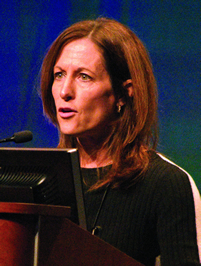At this year’s Clinicopathologic Conference, a team of four physicians from the National Institutes of Health and George Washington University presented a case study of a rare inflammatory disease and the series of imaging and pathology tests they conducted to finally arrive at a diagnosis.
Shubhasree Banerjee, MD, a rheumatology fellow with the National Institute of Arthritis and Musculoskeletal and Skin Diseases at the NIH, described the case of a 74-year-old Caucasian male of Italian ancestry who was admitted to the intensive care unit with double vision, vomiting, and uncontrolled eye movements. There was no evidence of stroke based on MRI and CT tests.
“About seven months prior to this presentation, [the patient] had started to have pain in his left outer thigh. He described the pain as excruciating, localized, deep-seated,” Dr. Banerjee said.
Pain persisted following laminectomy. The patient also had chronic back pain. Because of the back pain, the patient underwent MRI tests of his spine, which revealed multilevel degenerative disc disease, bulging disc, and bilateral perinephric stranding, characterized by edema in the fat around the kidneys.
Rheumatologists were called for consult because CT of the head and neck showed that the patient had aortitis marked by thickening of the V4 segment of the left vertebral artery, right innominate artery, and descending thoracic artery.

Kathleen Brindle, MD, Diagnostic Radiologist at George Washington University, walked the audience through the imaging results. About 10 months after the patient first presented with thigh pain, he received a nuclear medicine bone scan.
“What is really impressive is the increased radiotracer uptake around his knees. There is this bilateral and fairly symmetric increased metabolic activity involving his distal femurs and proximal tibias bilaterally,” Dr. Brindle explained.
The patient underwent biopsy of the left distal femur to better understand the tissue damage.
Elaine S. Jaffe, MD, Senior Investigator of Pathology at the National Cancer Institute Center for Cancer Research at the NIH showed a series of histologic images that revealed marked sclerosis, remodeling of the bone, infiltration of histiocyte cells, and no infiltration of B or T cells.
An additional study found the histiocyte cells were positive for mutations in the BRAF gene called BRAF-V600E.
Given the pathologic findings, the audience was asked to vote on the diagnosis among seven possible diseases. Most of the audience correctly diagnosed Erdheim-Chester disease (ECD).
Although ECD was first described in 1930, it stayed under the radar until 1996, and it was not until 2005 that the first treatment, interferon alpha, was offered to patients, said Juvianee I. Estrada Veras, MD, Clinical Investigator and Staff Clinician at The National Human Genome Research Institute at the NIH.
The ECD Global Alliance, a patient advocacy group, was created in 2009, and since then there has been a milestone in ECD treatment and understanding each year, Dr. Estrada said.
“Even though it is hard to diagnose, ECD has distinct histologic and immunohistochemical and radiologic pattern,” Dr. Estrada said.
The disease is marked by excessive histiocyte accumulation, which can affect a single organ or multiple organs, causing them to become thickened and fibrotic, and potentially leading to kidney, cardiovascular, lung, and central nervous system disease, among other types of organ involvement.
Some of the clinical manifestations that can hint at a diagnosis of ECD are pain in the lower extremities and swelling at the eye canthus, both of which the patient in the case study exhibited. However, ECD is also associated with non-specific symptoms, such as fatigue, generalized weakness, and cognitive decline, all of which the patient also exhibited.
The first-line treatment for ECD includes interferon alpha, and other options are imatinib, anakinra, methotrexate, and cladribrine.
“However, with precision medicine and new inhibitors of pathways, molecular testing is a must in all cases since the new therapies are promising,” Dr. Estrada said.
Clinical trials are underway at the NIH, Memorial Sloan Kettering Cancer Center, and MD Anderson Cancer Center to test BRAF and MEK inhibitors in ECD patients. About 50 percent of ECD patients have the BRAF-V600E mutation in affected histiocytes, and patients have on average a total of 7.7 somatic mutations in these histiocytes. In 2016, the World Health Organization classified ECD as a histiocytic and dendritic cell neoplasm in 2016.
Dr. Estrada recommended that clinicians read the consensus guidelines that he and his colleagues published in 2014 on the diagnosis and clinical management of ECD, and reach out to any of the authors for further information.
